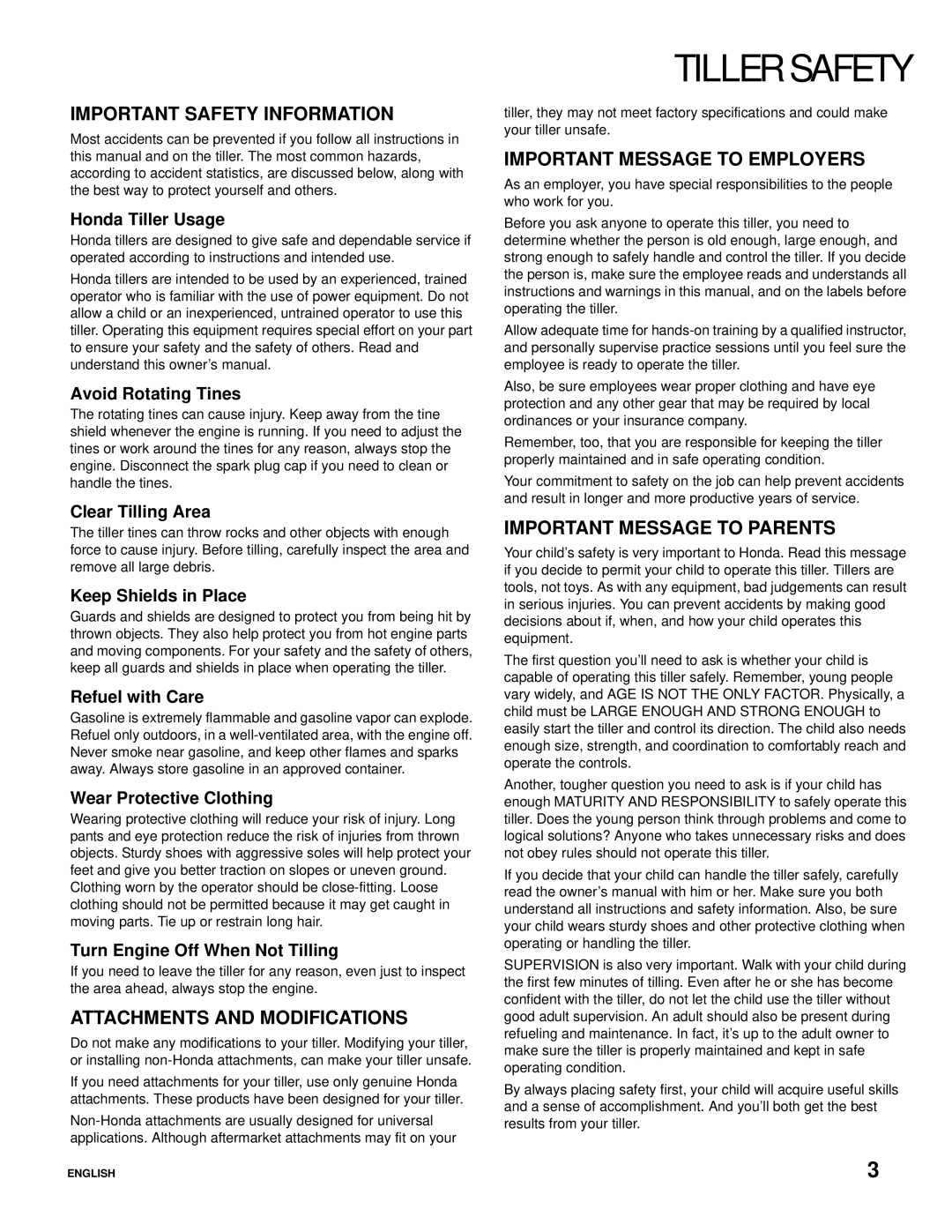IMPORTANT SAFETY INFORMATION
Most accidents can be prevented if you follow all instructions in this manual and on the tiller. The most common hazards, according to accident statistics, are discussed below, along with the best way to protect yourself and others.
Honda Tiller Usage
Honda tillers are designed to give safe and dependable service if operated according to instructions and intended use.
Honda tillers are intended to be used by an experienced, trained operator who is familiar with the use of power equipment. Do not allow a child or an inexperienced, untrained operator to use this tiller. Operating this equipment requires special effort on your part to ensure your safety and the safety of others. Read and understand this owner’s manual.
Avoid Rotating Tines
The rotating tines can cause injury. Keep away from the tine shield whenever the engine is running. If you need to adjust the tines or work around the tines for any reason, always stop the engine. Disconnect the spark plug cap if you need to clean or handle the tines.
Clear Tilling Area
The tiller tines can throw rocks and other objects with enough force to cause injury. Before tilling, carefully inspect the area and remove all large debris.
Keep Shields in Place
Guards and shields are designed to protect you from being hit by thrown objects. They also help protect you from hot engine parts and moving components. For your safety and the safety of others, keep all guards and shields in place when operating the tiller.
Refuel with Care
Gasoline is extremely flammable and gasoline vapor can explode. Refuel only outdoors, in a well-ventilated area, with the engine off. Never smoke near gasoline, and keep other flames and sparks away. Always store gasoline in an approved container.
Wear Protective Clothing
Wearing protective clothing will reduce your risk of injury. Long pants and eye protection reduce the risk of injuries from thrown objects. Sturdy shoes with aggressive soles will help protect your feet and give you better traction on slopes or uneven ground. Clothing worn by the operator should be close-fitting. Loose clothing should not be permitted because it may get caught in moving parts. Tie up or restrain long hair.
Turn Engine Off When Not Tilling
If you need to leave the tiller for any reason, even just to inspect the area ahead, always stop the engine.
ATTACHMENTS AND MODIFICATIONS
Do not make any modifications to your tiller. Modifying your tiller, or installing non-Honda attachments, can make your tiller unsafe.
If you need attachments for your tiller, use only genuine Honda attachments. These products have been designed for your tiller.
Non-Honda attachments are usually designed for universal applications. Although aftermarket attachments may fit on your
TILLER SAFETY
tiller, they may not meet factory specifications and could make your tiller unsafe.
IMPORTANT MESSAGE TO EMPLOYERS
As an employer, you have special responsibilities to the people who work for you.
Before you ask anyone to operate this tiller, you need to determine whether the person is old enough, large enough, and strong enough to safely handle and control the tiller. If you decide the person is, make sure the employee reads and understands all instructions and warnings in this manual, and on the labels before operating the tiller.
Allow adequate time for hands-on training by a qualified instructor, and personally supervise practice sessions until you feel sure the employee is ready to operate the tiller.
Also, be sure employees wear proper clothing and have eye protection and any other gear that may be required by local ordinances or your insurance company.
Remember, too, that you are responsible for keeping the tiller properly maintained and in safe operating condition.
Your commitment to safety on the job can help prevent accidents and result in longer and more productive years of service.
IMPORTANT MESSAGE TO PARENTS
Your child’s safety is very important to Honda. Read this message if you decide to permit your child to operate this tiller. Tillers are tools, not toys. As with any equipment, bad judgements can result in serious injuries. You can prevent accidents by making good decisions about if, when, and how your child operates this equipment.
The first question you’ll need to ask is whether your child is capable of operating this tiller safely. Remember, young people vary widely, and AGE IS NOT THE ONLY FACTOR. Physically, a child must be LARGE ENOUGH AND STRONG ENOUGH to easily start the tiller and control its direction. The child also needs enough size, strength, and coordination to comfortably reach and operate the controls.
Another, tougher question you need to ask is if your child has enough MATURITY AND RESPONSIBILITY to safely operate this tiller. Does the young person think through problems and come to logical solutions? Anyone who takes unnecessary risks and does not obey rules should not operate this tiller.
If you decide that your child can handle the tiller safely, carefully read the owner’s manual with him or her. Make sure you both understand all instructions and safety information. Also, be sure your child wears sturdy shoes and other protective clothing when operating or handling the tiller.
SUPERVISION is also very important. Walk with your child during the first few minutes of tilling. Even after he or she has become confident with the tiller, do not let the child use the tiller without good adult supervision. An adult should also be present during refueling and maintenance. In fact, it’s up to the adult owner to make sure the tiller is properly maintained and kept in safe operating condition.
By always placing safety first, your child will acquire useful skills and a sense of accomplishment. And you’ll both get the best results from your tiller.
